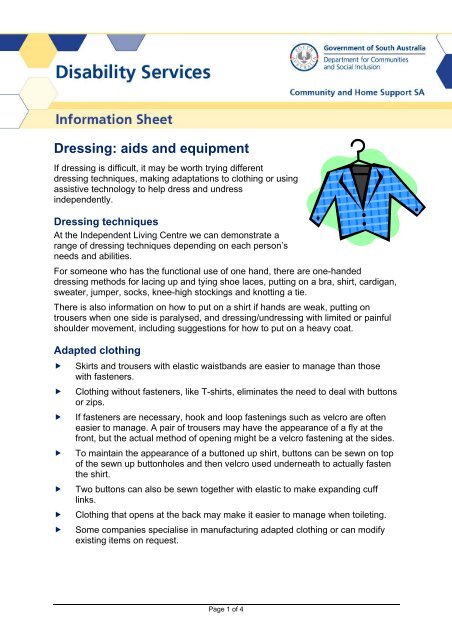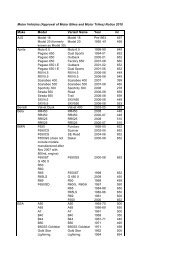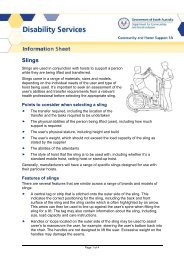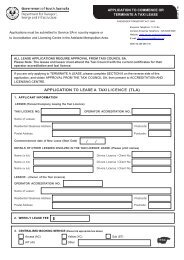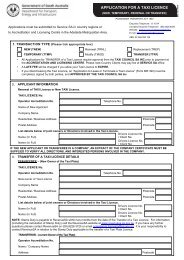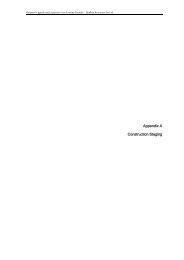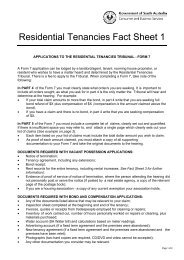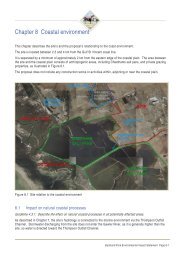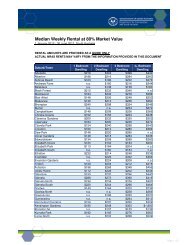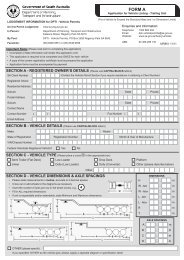Dressing: aids and equipment (PDF 94KB) - SA.Gov.au
Dressing: aids and equipment (PDF 94KB) - SA.Gov.au
Dressing: aids and equipment (PDF 94KB) - SA.Gov.au
You also want an ePaper? Increase the reach of your titles
YUMPU automatically turns print PDFs into web optimized ePapers that Google loves.
<strong>Dressing</strong>: <strong>aids</strong> <strong>and</strong> <strong>equipment</strong><br />
If dressing is difficult, it may be worth trying different<br />
dressing techniques, making adaptations to clothing or using<br />
assistive technology to help dress <strong>and</strong> undress<br />
independently.<br />
<strong>Dressing</strong> techniques<br />
At the Independent Living Centre we can demonstrate a<br />
range of dressing techniques depending on each person’s<br />
needs <strong>and</strong> abilities.<br />
For someone who has the functional use of one h<strong>and</strong>, there are one-h<strong>and</strong>ed<br />
dressing methods for lacing up <strong>and</strong> tying shoe laces, putting on a bra, shirt, cardigan,<br />
sweater, jumper, socks, knee-high stockings <strong>and</strong> knotting a tie.<br />
There is also information on how to put on a shirt if h<strong>and</strong>s are weak, putting on<br />
trousers when one side is paralysed, <strong>and</strong> dressing/undressing with limited or painful<br />
shoulder movement, including suggestions for how to put on a heavy coat.<br />
Adapted clothing<br />
Skirts <strong>and</strong> trousers with elastic waistb<strong>and</strong>s are easier to manage than those<br />
with fasteners.<br />
Clothing without fasteners, like T-shirts, eliminates the need to deal with buttons<br />
or zips.<br />
If fasteners are necessary, hook <strong>and</strong> loop fastenings such as velcro are often<br />
easier to manage. A pair of trousers may have the appearance of a fly at the<br />
front, but the actual method of opening might be a velcro fastening at the sides.<br />
To maintain the appearance of a buttoned up shirt, buttons can be sewn on top<br />
of the sewn up buttonholes <strong>and</strong> then velcro used underneath to actually fasten<br />
the shirt.<br />
Two buttons can also be sewn together with elastic to make exp<strong>and</strong>ing cuff<br />
links.<br />
Clothing that opens at the back may make it easier to manage when toileting.<br />
Some companies specialise in manufacturing adapted clothing or can modify<br />
existing items on request.<br />
Page 1 of 4
Assistive technology/<strong>equipment</strong> to aid dressing<br />
Buttonhooks<br />
A buttonhook can be used to do up buttons by pushing the hook through the<br />
buttonhole, looping over the button <strong>and</strong> pulling it back through the hole.<br />
Some buttonhooks are available with larger h<strong>and</strong>les to assist those with weak grasp<br />
<strong>Dressing</strong> sticks<br />
A dressing stick usually features a hook at one end <strong>and</strong> sometimes a thimble on the<br />
other end. It has a range of uses including pushing sleeves off shoulders <strong>and</strong> pulling<br />
up pants. Loops can be sewn onto clothing <strong>and</strong> the dressing stick used to hook into<br />
the loops <strong>and</strong> pull up <strong>and</strong> position the garment.<br />
Zips<br />
Large rings or tape can be attached to the zip to assist grasp. A dressing stick can be<br />
used to hook into zip rings that are difficult to reach. Another option is to replace the<br />
zip with a velcro fastening.<br />
Shoes<br />
Long-h<strong>and</strong>led shoehorns may assist with putting on shoes <strong>and</strong> eliminate the<br />
need to bend down. There is a pickup reacher that has a plastic shoehorn<br />
attached to one end; this can assist in both putting shoes on <strong>and</strong> pulling up<br />
socks.<br />
If shoelace tying is difficult, elastic shoelaces or coil (spring) laces enable the<br />
shoe to be slipped on <strong>and</strong> off without tying <strong>and</strong> untying.<br />
Cord <strong>and</strong> barrel locks can also be used as a securing <strong>and</strong> tightening device.<br />
Shoe buttons are made of plastic <strong>and</strong> screw through the top pair of lace holes in<br />
a lace up shoe. A tied shoelace can then be pulled over the button to fasten,<br />
reducing the number of times the shoelace has to be tied <strong>and</strong> untied.<br />
Another easy shoe option is to consider slip on shoes or those that fasten with<br />
velcro.<br />
Ortholace is a velcro attachment which can be applied to lace up shoes. It<br />
allows one-h<strong>and</strong>ed adjustment of laces by pulling across the Velcro mechanism<br />
to tighten up the laces <strong>and</strong> shoe.<br />
Customised shoes can be made with easier to manage fasteners <strong>and</strong> are<br />
designed to open more fully to assist with placing the foot into the shoe.<br />
To assist with removing boots or shoes a Boot Jack might be of assistance. It<br />
features a curved cut out area at one end to accommodate the heel of the shoe<br />
or boot while the other foot is placed on the other end to hold it stable, while the<br />
boot is pulled off.<br />
If putting on slippers is an issue, there are medical sheepskin slippers available<br />
with a wide opening tongue that fastens with velcro. Some designs open up<br />
totally flat <strong>and</strong> then fasten around the heel <strong>and</strong> across the top of the foot with a<br />
wide velcro strip. Some feature a rubber non-slip sole.<br />
Page 2 of 4
Socks, stockings <strong>and</strong> pantyhose<br />
Aids are available to assist in putting on socks, stockings <strong>and</strong> pantyhose when it<br />
is difficult to bend down <strong>and</strong> reach them.<br />
These <strong>aids</strong> are generally made of flexible plastic that are bent into a gutter<br />
shape. The sock or stocking is pulled onto the plastic <strong>and</strong> there are cotton tapes<br />
that are held while the aid with the sock is lowered to the floor. The tapes are<br />
pulled upwards <strong>and</strong> the sock slides onto the foot as the aid is pulled out of the<br />
sock.<br />
Some techniques that may assist in reaching feet to put socks on include sitting<br />
down <strong>and</strong> placing the foot on a low stool, or crossing legs so that the calf of one<br />
leg is resting on the knee of the other leg.<br />
Compression stockings<br />
Compression stockings can be particularly difficult to apply bec<strong>au</strong>se of the<br />
strong elasticity of the stocking, difficulty reaching down to the end of the foot<br />
<strong>and</strong> possible increased size of the foot <strong>and</strong> leg due to swelling.<br />
A variety of compression stocking <strong>aids</strong> are available to assist in putting on<br />
compression stockings, including options for both open toe or closed toe<br />
stockings.<br />
To remove compression stockings there is a long-h<strong>and</strong>led device that has an<br />
end like a small shoehorn that slides along the leg with a hook that hooks over<br />
the stocking edge <strong>and</strong> slides it down.<br />
Other tips that may make putting on compression stockings a bit simpler<br />
include; wearing rubber gloves to improve grip <strong>and</strong> avoid piercing the stockings,<br />
<strong>and</strong> using a footstool with a non-slip mat on it to bring the foot closer to reach.<br />
Bras<br />
If a bra is very difficult to fasten at the back, consider purchasing a front opening<br />
bra.<br />
If the hook <strong>and</strong> eye fastenings are too small <strong>and</strong> difficult to manage a bra can<br />
be altered to have a front opening where velcro is threaded through a ‘D ring’<br />
<strong>and</strong> pulled back on itself.<br />
Another option is to purchase a ‘fastener free bra’, which involves pulling the<br />
bra on from over the head or stepping into it <strong>and</strong> pulling it up into position.<br />
An aid is available which aims to assist with putting on a bra one-h<strong>and</strong>ed. It<br />
secures one side of the bra at the front while the other side of the bra is<br />
attached to it.<br />
Page 3 of 4
Contacting the Independent Living Centre<br />
For further information or to make an appointment to visit the display please contact<br />
the Independent Living Centre. The Independent Living Centre offers free advice on<br />
<strong>equipment</strong> <strong>and</strong> techniques to help you with everyday tasks.<br />
Independent Living Centre<br />
11 Blacks Road<br />
Gilles Plains <strong>SA</strong> 5086<br />
Phone: 1300 885 886 (<strong>SA</strong> & NT callers only) or 8266 5260<br />
Fax: 8266 5263<br />
Email: ilcsa@dcsi.sa.gov.<strong>au</strong><br />
Website: www.sa.gov.<strong>au</strong>/disability/ilc<br />
Accessible off street parking is available.<br />
Bus routes:<br />
From the city T500/T501 or<br />
207/208 to Stop 28 Sudholz Road<br />
Timetable information: 8210 1000<br />
Copies of this publication are available from the Disability Information Service<br />
Tel: 1300 786 117 Email: disabilityinfo@dcsi.sa.gov.<strong>au</strong> Website: www.sa.gov.<strong>au</strong>/disability Version: July 2012<br />
Licensed under Creative Commons http://creativecommons.org/licenses/by-nd/3.0<br />
Attribute to: The Dept for Communities <strong>and</strong> Social Inclusion, <strong>Gov</strong>ernment of South Australia


